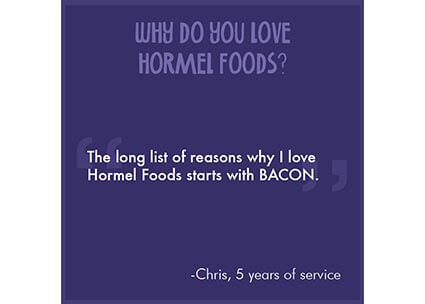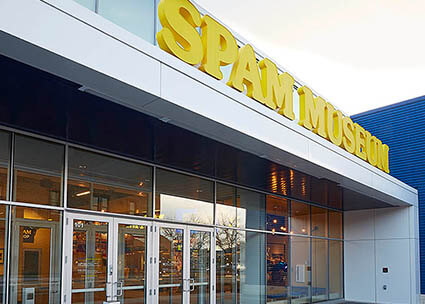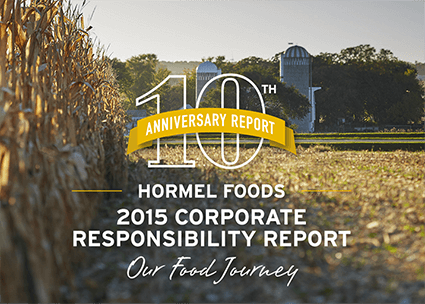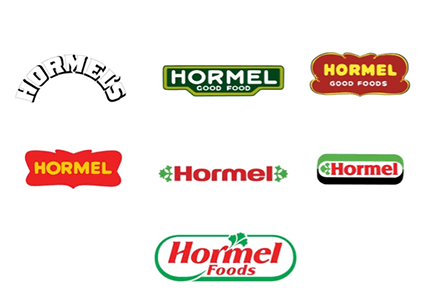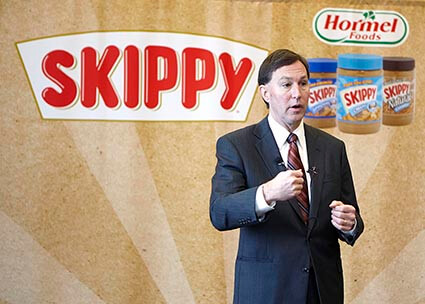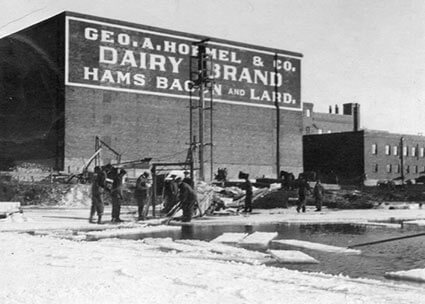-
What’s Next: Another 125 Years of Elevating the Everyday
The company is celebrating its 125th anniversary in 2016, along with the grand opening of the new SPAM® Museum in downtown Austin, Minn. In March 2016, Jeffrey M. Ettinger, chairman of the board and chief executive officer, was named one of the World’s Best CEOs by Barron’s. The business units are led by the company’s 10th president, James P. Snee. A two-for-one stock split, the second in five years for the company, was approved by stockholders in January.
-
More than Meat: A Protein Powerhouse
Under the leadership of Jeffrey M. Ettinger, the company made over 10 acquisitions, including SKIPPY® peanut butter, CytoSport, Inc., maker of Muscle Milk® products, and Applegate Farms, maker of natural and organic meats, as well as the joint-venture formation of MegaMex Foods. These strategic acquisitions have enabled the company to further expand and strengthen its position within the protein category by including non-meat and natural and organic proteins. The company began reporting on its corporate responsibility initiatives in 2007. The $1 billion and $2 billion innovation challenges were introduced consecutively to spark sales in the new products category and were both quickly achieved. The SPAM® brand celebrated its 75th anniversary in 2012 with the help of the company’s first-ever campaign spokescharacter, Sir Can-A-Lot™. Project SPAMMY®, the company’s childhood malnutrition initiative in Guatemala, began in 2011, and in 2015 the product was made available for use in domestic and international feeding programs.
-
A New Name, A New Century
In 1993, Geo. A. Hormel & Co. was officially renamed Hormel Foods Corporation to more accurately reflect the company’s presence in the industry. Joel W. Johnson capitalized on this change, and guided the company with a marketing perspective to incorporate new technologies, such as brand-specific websites. Quality products continued to be a standard across the company, along with value-added strategies and proven cost control methods. Export tonnage rose over 30 percent as numerous acquisitions and joint-ventures grew the company’s global presence. A large contributor to this was the acquisition of The Turkey Store company, which was merged with Jennie-O Foods to create one of the largest turkey processors in the U.S., Jennie-O Turkey Store.
-
An Era of Teamwork and Innovation
The company was guided through a whirlwind of intense industry competition and innovation by R. L. “Dick” Knowlton. The company’s product portfolio continued to expand through acquisitions, such as Jennie-O Foods, and new product developments such as frozen and shelf-stable microwavable items. These leaps forward were commemorated by industry awards praising the company’s success. At the same time, a 13-month strike occurred, which ended in 1986. The company began trading on the New York Stock Exchange in 1990 and announced its seventh two-for-one stock split since its inauguration as a publicly-traded entity.
-
People, Products and New Plants
I.J. “Jim” Holton led the company during an era of unprecedented investments and ideas. The company expanded its international presence and built 10 new domestic facilities. The decision was also made to build a flagship plant in Austin, Minn., further solidifying the company’s small town roots. In 1971, the company launched its largest national advertising campaign to date for Hormel® Cure 81® hams. Two years later, the company added nutritional and ingredient labeling on all products – the first in the meatpacking industry to do so. After reorganizing into distinct business segments, annual sales topped $1 billion for the first time in 1976.
-
From Meatpacker to Marketer
The company solidified its national reach by establishing manufacturing and distribution sites across the country. Under leadership of R. F. “Bob” Gray and then M. B. “Tommy” Thompson, the company shifted its focus from high-volume production to market-driven, innovative products. Iconic products such as Hormel® Little Sizzlers® pork sausage and Hormel® Cure 81® hams were introduced during this era, and the SPAM® brand had produced its 1 billionth can. A new company logo debuted in 1964, showcasing the iconic parsley leaf for the first time. The company focused on increasing sales efforts, a unique approach differing from the traditional meatpacking mindset.
-
Tackling Business in Postwar America
After World War II, the company saw its first leader from outside the Hormel family, H. H. “Tim” Corey. During this time, the Hormel Girls musical troupe helped to uniquely advertise the company’s growing line of products. Hormel® Mary Kitchen® beef hashes were introduced, along with a dozen other new products to capitalize on the popular trend toward convenience-packaged products. Multiple facilities were built and purchased to accommodate increasing consumer demand, including the contracting of production space overseas. The company processed its 50 millionth hog in 1952, and saw annual sales climb to $250 million by its 60th year of business.
-
The Master of Invention
The transfer of leadership to Jay C. Hormel brought with it a daring new set of ideas for management, products and advertising. Employees were brought to the forefront of focus with the establishment of guaranteed annual wages, a joint-earnings plan and an employee profit sharing trust. Legacy products Dinty Moore® beef stew, Hormel® chili and SPAM® luncheon meat were introduced. They were immediate successes and the iconic Dairy Brand line of products continued to thrive. The Hormel Foundation was created in 1941, and The Hormel Institute followed the next year. Sales offices were established in 14 cities around the country as the company expanded rapidly.
-
The Gritty Entrepreneur
Geo. A. Hormel & Co. began in small but thriving Austin, Minn., in 1891. Innovative products such as Canadian bacon and canned hams helped differentiate the company and stimulate growth. When federal meat inspection began in 1906, the company received stellar sanitation and cleanliness marks, establishing a tradition of quality. In 1911, the first national advertising for the company appeared in Ladies Home Journal. Annual sales were nearing $30 million in 1920 with George A. Hormel at the helm, up from $220,000 in the company’s first year. With a provision market in Austin, Minn., and distribution centers across the country, the company was off to a promising start.
- In Quest of Quality: Hormel’s first 75 Years, by Richard Dougherty
- Inside Hormel Foods magazine, years 2008-2016
- HormelFoods.com
- The Hormel Legacy: 100 Years of Quality, by Dr. Doniver A. Lund and V. Allan Krejci



